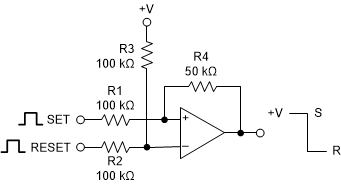SNOSDJ3 May 2024 TLV1812-EP
ADVANCE INFORMATION
- 1
- 1Features
- 2Applications
- 3Description
- Pin Configuration and Functions
- 4Specifications
- 5Detailed Description
-
6Application and Implementation
- 6.1 Application Information
- 6.2 Typical Applications
- 6.3 Power Supply Recommendations
- 6.4 Layout
- 7Device and Documentation Support
- 8Revision History
- 9Mechanical, Packaging, and Orderable Information
Package Options
Mechanical Data (Package|Pins)
- DDF|8
Thermal pad, mechanical data (Package|Pins)
Orderable Information
6.2.7 Bi-Stable Multivibrator
 Figure 6-16 Bi-Stable Multivibrator
Figure 6-16 Bi-Stable MultivibratorA bi-stable multivibrator has two stable states. The reference voltage is set up by the voltage divider of R2 and R3. A pulse applied to the SET terminal will switch the output of the comparator high. The resistor divider of R1 and R4 now sets the non-inverting input to a voltage greater than the reference voltage. A pulse applied to RESET will now toggle the output low.